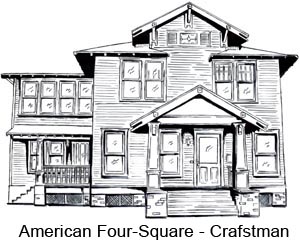Audubon – Architectural Styles
Audubon Place Historic District Site
Architectural Styles
The historic houses in Audubon Place are one and two stories tall. They were built predominantly in the Craftsman, Prairie, and Colonial Revival styles. The district also contains several older apartment buildings, as well as modern apartments and townhouses and some commercial development.
The Arts and Crafts Movement became popular in the early 1900s. It was a shift away from the intricate decoration that was fashionable in the late 1800s. Arts and Crafts emphasized order and restraint in the decorative arts. The Craftsman and Prairie building styles were developed during this period. Between 1900 and 1930, these were the most popular architectural styles in America.
The Craftsman style is often associated with a form of house called a bungalow. Both the Craftsman style and the bungalow were developed in California by Greene and Greene, a pair of architects who were brothers. Bungalows have low-pitched roofs with wide eaves. Decorations are prominent, but simplified. Craftsman houses are often identified by the brackets under the eaves of the roof.
Craftsman details are often found on bungalows. However, not all bungalows were built in the Craftsman style. Also, sometimes Craftsman details were applied to other types of houses, such as the American Four Square.
American Four Square houses are two rooms wide and two rooms deep. In other words, each floor has four rooms in a square shape. These houses may be one or two stories tall. In Houston, these are usually two-story houses with decorative details from the Craftsman, Prairie, or Colonial Revival styles.
Colonial Revival houses are meant to look like houses built around the time of the Revolutionary War. The most common Colonial Revival houses are two stories tall. They are rectangular, with a hipped or side-gabled roof. The front door is usually located in the center of the front façade. The door is often accentuated with a porch or decorative trim. Front windows are arranged symmetrically. Other shapes and configurations are also possible.
The Prairie style was developed in Chicago by architect Frank Lloyd Wright. It was used on large houses and on commercial buildings. Buildings in the Prairie style were wide, with flat, horizontal features. They were supposed to recall the flat, treeless plains of the Midwestern United States. Prairie houses are very common in the Audubon Place neighborhood.
Defining Features
The historic houses in Audubon Place are one and two stories tall. They were built predominantly in the Craftsman, Prairie, and Colonial Revival styles. The district also contains several older apartment buildings, as well as modern apartments and townhouses and some commercial development.
The Arts and Crafts Movement became popular in the early 1900s. It was a shift away from the intricate decoration that was fashionable in the late 1800s. Arts and Crafts emphasized order and restraint in the decorative arts. The Craftsman and Prairie building styles were developed during this period. Between 1900 and 1930, these were the most popular architectural styles in America.
The Craftsman style is often associated with a form of house called a bungalow. Both the Craftsman style and the bungalow were developed in California by Greene and Greene, a pair of architects who were brothers. Bungalows have low-pitched roofs with wide eaves. Decorations are prominent, but simplified. Craftsman houses are often identified by the brackets under the eaves of the roof.
Craftsman details are often found on bungalows. However, not all bungalows were built in the Craftsman style. Also, sometimes Craftsman details were applied to other types of houses, such as the American Four Square.
American Four Square houses are two rooms wide and two rooms deep. In other words, each floor has four rooms in a square shape. These houses may be one or two stories tall. In Houston, these are usually two-story houses with decorative details from the Craftsman, Prairie, or Colonial Revival styles.
Colonial Revival houses are meant to look like houses built around the time of the Revolutionary War. The most common Colonial Revival houses are two stories tall. They are rectangular, with a hipped or side-gabled roof. The front door is usually located in the center of the front façade. The door is often accentuated with a porch or decorative trim. Front windows are arranged symmetrically. Other shapes and configurations are also possible.
The Prairie style was developed in Chicago by architect Frank Lloyd Wright. It was used on large houses and on commercial buildings. Buildings in the Prairie style were wide, with flat, horizontal features. They were supposed to recall the flat, treeless plains of the Midwestern United States. Prairie houses are very common in the Audubon Place neighborhood.
| Compatible | Incompatible | |
| Foundation |
|
|
| Front Porch |
|
|
| Roof |
|
|
| Exterior Wall Cladding |
|
|
| Front Door |
|
|
| Windows |
|
|



